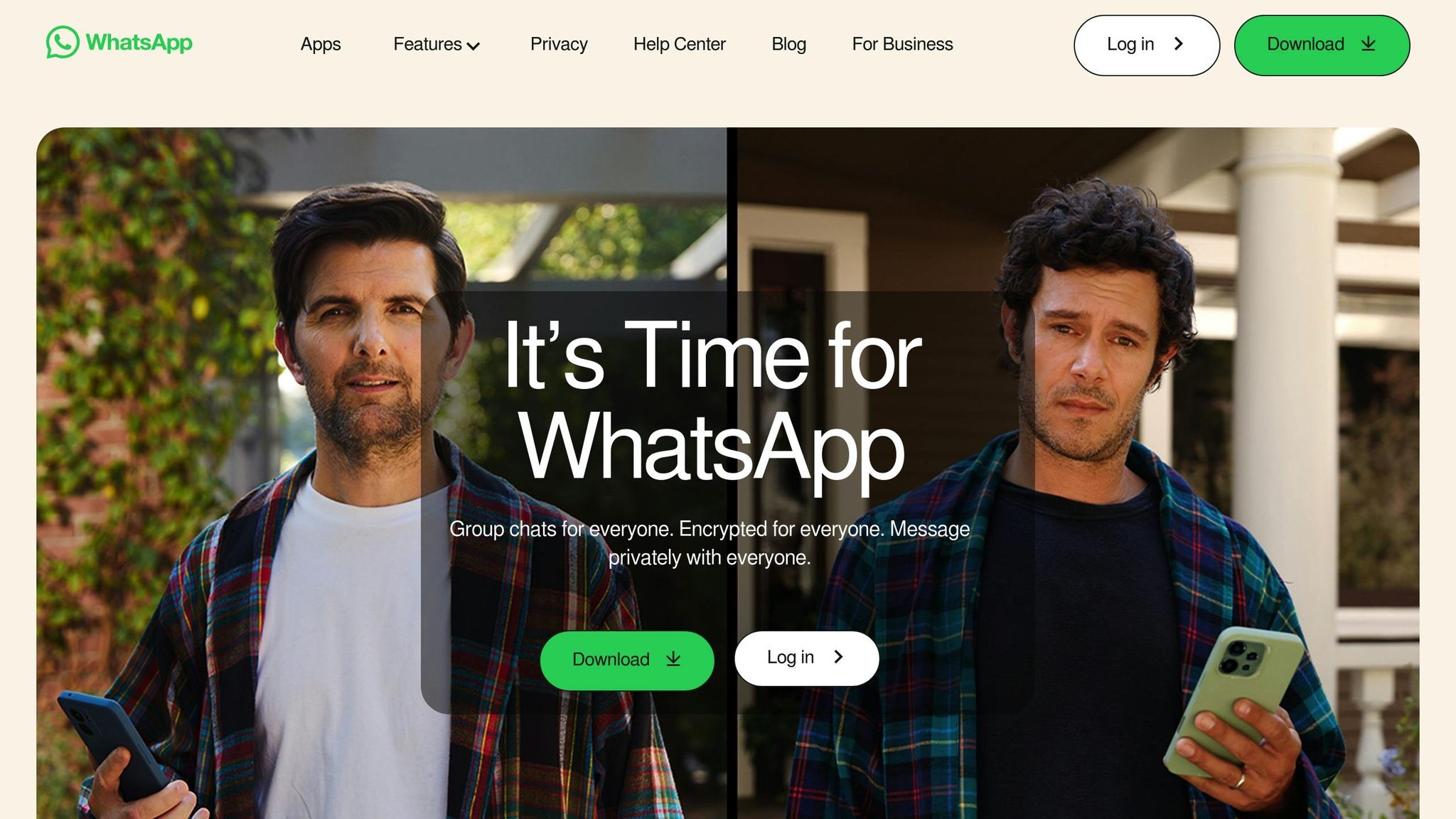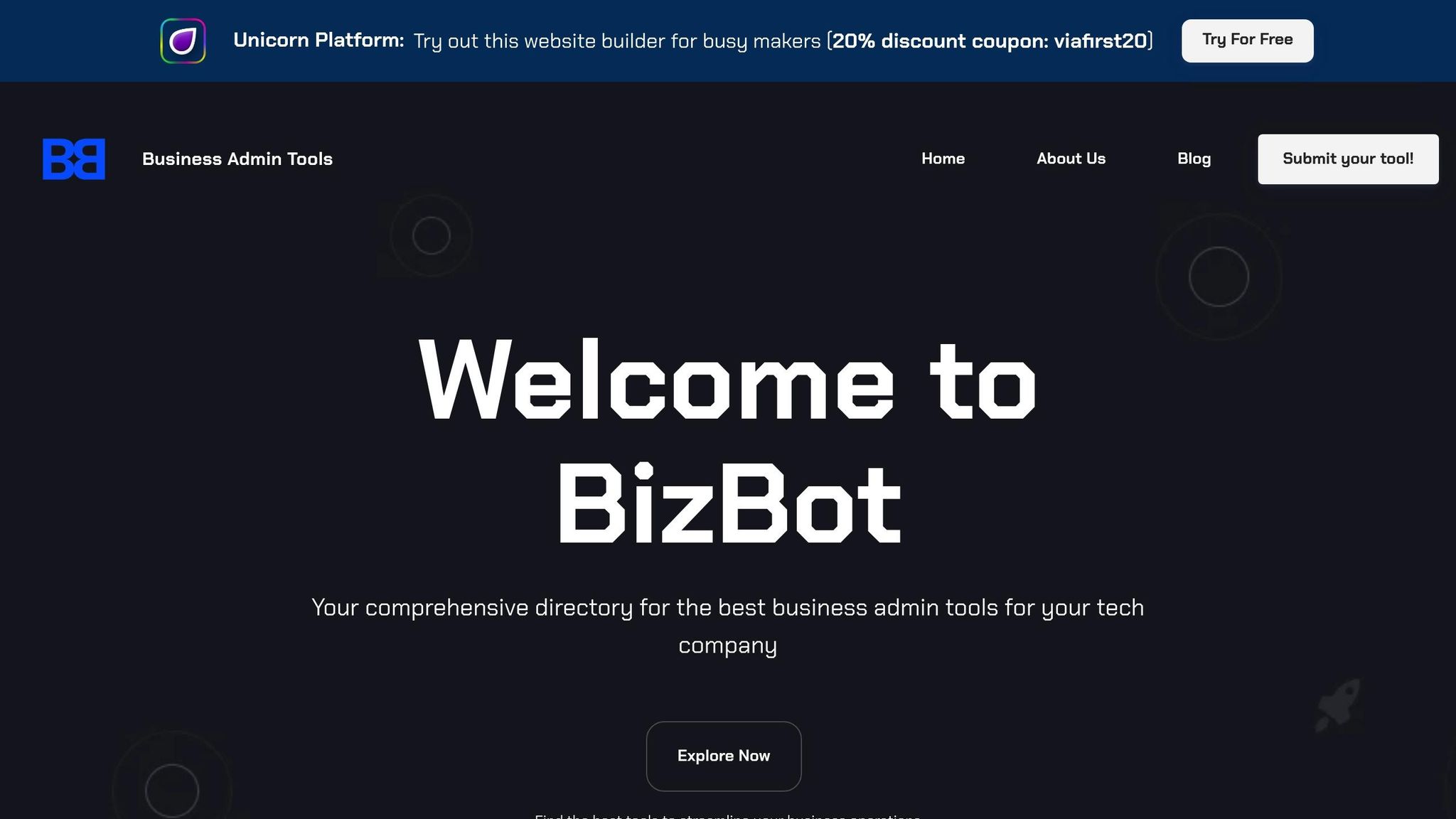Cross-device messaging is no longer optional for businesses. Customers and employees expect uninterrupted communication across phones, laptops, tablets, and desktops. This guide explains how businesses can create a unified messaging experience that synchronizes conversations, data, and context in real time, improving efficiency, customer satisfaction, and collaboration.
Key Takeaways:
- What It Is: Cross-device messaging synchronizes messages across devices in a single channel, unlike multi- or cross-channel messaging.
- Why It Matters: Remote work, hybrid teams, and multi-device customer interactions demand seamless communication to avoid lost context and inefficiencies.
- Core Benefits:
- Real-time updates across all devices.
- Improved workflows and automation.
- Personalized customer experiences using unified data.
- Features to Look For:
- Instant synchronization.
- Secure cloud storage.
- Smart notifications and cross-platform compatibility.
- Integration with tools like CRM and project management software.
- Challenges:
- Managing device fragmentation and security risks.
- Ensuring compliance with data regulations.
- Implementation Tips:
- Start with a pilot group and clear success metrics.
- Train employees and integrate with existing tools.
- Use centralized data management to eliminate silos.
Cross-device messaging not only meets modern communication needs but also prepares businesses for future trends like AI-driven personalization and privacy-first synchronization.
Scaling Business Messaging at WhatsApp | Vikram Bodicherla

Key Benefits of Cross-Device Messaging
Cross-device messaging enhances customer satisfaction, streamlines operations, and drives revenue growth.
Better User Experience
A smooth, uninterrupted experience across devices removes barriers for users. Imagine starting a conversation or task on your phone and effortlessly picking it up on your laptop without losing any context. This kind of continuity not only keeps users engaged but also encourages actions like completing purchases.
Take Amazon, for example. Customers can browse products and add items to their cart on a laptop, then switch to a phone or tablet and find their cart perfectly synced. This creates a hassle-free shopping experience that keeps users coming back.
Additionally, task continuity means customers don’t have to start over when switching devices. This consistency is especially important for accessibility, ensuring a broader audience can interact with your brand seamlessly. With over 2 billion Android users worldwide, businesses need to ensure their messaging works smoothly across different devices and operating systems to avoid alienating potential customers.
For teams, this unified access translates into uninterrupted workflows, allowing employees to pick up tasks from any device. This not only boosts productivity but also sets the stage for more efficient operations, which we'll explore next.
Higher Efficiency and Automation
Cross-device messaging simplifies workflows by centralizing data and automating updates. Instead of juggling multiple systems or hunting for conversation history across platforms, teams gain access to a unified interface that updates in real time.
Automation plays a key role here. Updates made on one device are instantly reflected across all others, eliminating repetitive tasks and reducing the need for manual handoffs.
When integrated into broader business processes, the benefits grow even further. Automated systems can trigger responses, assign inquiries to the right team members, and update customer records seamlessly - regardless of the device being used. This level of integration allows teams to collaborate in real time across phones, tablets, and computers, saving time and minimizing disruptions caused by switching devices. Ultimately, these streamlined operations open the door to more personalized, data-driven strategies.
Personalization and Data-Driven Insights
Beyond convenience and efficiency, cross-device messaging unlocks deeper customer understanding. By consolidating data from multiple devices, businesses can create unified customer profiles that reveal a complete picture of user behavior and preferences. These insights help identify patterns that might otherwise be missed.
This comprehensive view makes targeting and personalization more effective. For instance, Amazon uses cross-device tracking to build detailed customer profiles. If a user browses a product on their phone, Amazon might later display an ad for that product when the user switches to their laptop. These personalized interactions feel timely and relevant, enhancing the overall customer experience.
Analyzing cross-device data also sharpens strategic decision-making. Understanding how customers move between devices, their preferred engagement times, and switching habits can inform choices about resource allocation, feature development, and communication methods. Armed with these insights, businesses can design proactive campaigns tailored to how customers interact across devices, ensuring every touchpoint feels intentional and engaging.
Core Features and Requirements for Cross-Device Messaging
Building an effective cross-device messaging system means incorporating specific features and a solid technical foundation. These elements are essential for businesses aiming to choose or develop a messaging solution that meets their needs.
Key Features of Cross-Device Messaging
Real-time synchronization is a must-have. When a message is sent from one device, it should instantly reflect on all others. For instance, if an employee sends a message from their phone, it should immediately appear on their desktop app without any lag.
Message persistence ensures that conversations don't vanish when devices go offline. With cloud storage, users can access their full message history even without an internet connection.
Presence indicators show real-time availability across devices. If a team member is active on their laptop, their status should be visible on other platforms, making it easier to know when they're reachable.
File and media synchronization allows seamless sharing of documents, images, and other attachments. For example, a photo shared via a mobile app should be accessible on a desktop platform, retaining its quality and metadata.
Push notifications should be smart enough to avoid duplicates. If a user is active on one device, the system should suppress notifications on others, reducing unnecessary interruptions while ensuring important messages are noticed.
Search functionality must perform consistently across devices. Whether users are looking for a message, file, or contact, they should be able to use the same keywords and filters, regardless of the platform.
Integration capabilities let the messaging system connect with existing business tools like CRM platforms, project management software, and email systems. This creates a seamless workflow where data flows effortlessly between applications.
These features rely on a strong technical and security framework, which is explored next.
Technical and Security Requirements
Network infrastructure plays a key role in performance. Reliable internet connectivity with enough bandwidth is essential to support real-time data synchronization for all users.
Device compatibility ensures the messaging system works smoothly across various devices and hardware setups. This includes adapting the interface for both touchscreen and traditional input methods.
Data encryption safeguards messages both in transit and at rest. End-to-end encryption ensures that only intended recipients can view messages, while encrypted storage protects conversation history. Standards like AES-256 should be used to maintain security.
Authentication and access control verify user identities across devices. Multi-factor authentication (MFA) adds an extra layer of security by requiring multiple forms of verification. Single sign-on (SSO) can simplify this process, allowing users to log in once and access the system on any device.
Compliance with U.S. data regulations is essential for maintaining privacy standards. Messaging systems should include features like data retention controls, user consent management, and options to delete or export user data. Industries like healthcare and finance may require additional compliance measures, such as HIPAA or SOX adherence.
Backup and recovery systems are necessary to maintain business continuity in case of server failures. Automated backups should store conversation histories, user settings, and configurations in separate locations, while robust recovery processes minimize downtime.
Scalability infrastructure allows the system to grow alongside the business. Cloud-based solutions are often preferred for their ability to adjust server capacity automatically based on user demand and message volume.
API availability supports custom integrations and future upgrades. Well-documented APIs make it easier for businesses to connect their messaging platform with proprietary tools or other specialized software that may not have built-in integration options.
Strategies for Implementing Cross-Device Messaging
Getting cross-device messaging right takes careful planning, smooth integration with existing tools, and solid support for your team to make the transition as seamless as possible.
Step-by-Step Implementation Process
Start by conducting a thorough needs assessment. Look for communication bottlenecks and analyze response times across departments. This will give you a clear picture of where improvements are needed and help you set practical goals for the new system.
Roll out the system in phases. Begin with a pilot group that includes members from different departments. This allows you to test the system, work out any kinks, and gather feedback before introducing it to the entire organization.
Define clear success metrics, like faster response times, improved file-sharing efficiency, or higher user engagement, to measure how well the system is performing early on.
Create a detailed budget that includes not just software costs but also training, temporary dips in productivity, and the need for technical support during the transition.
Check compatibility across all devices used in your organization. Take inventory of smartphones, tablets, laptops, and desktops, and ensure the system works smoothly across different operating systems and browsers.
Plan data migration carefully. Move histories, contacts, and attachments during off-peak hours to avoid major disruptions.
Once you’ve got these foundational steps in place, shift your focus to integrating the messaging tools with your existing systems.
Integrating with Existing Business Tools
Start by identifying the tools your team uses the most - like project management platforms or customer relationship management systems - and prioritize integrating those first. This ensures the tools that have the biggest impact on your workflow are ready to go.
Implement single sign-on (SSO) to simplify logins and boost security. This reduces the hassle of managing multiple passwords and saves time.
Sync your messaging platform with calendar tools to make scheduling easier. For example, team members can set up meetings directly from chat conversations, and their availability can update automatically based on their calendars.
Integrate file storage systems to avoid duplicate uploads and confusion over document versions. Whether your organization uses cloud storage or on-premises servers, linking them to the messaging platform makes sharing files more efficient.
If the messaging system supports external communications, connect it to tools like help desk software or ticketing systems. This gives support teams quick access to customer histories, allowing them to resolve issues faster and more effectively.
Automate workflows by linking your messaging platform with project management tools. For example, set up notifications that alert team members about project updates without requiring manual input.
Employee Training and Support
Create training materials tailored to each department’s specific needs. Show employees how the messaging platform can make their daily tasks easier and more efficient.
Promote peer mentoring and offer multiple support channels, such as video tutorials, a help desk, or a dedicated chat group, to quickly address technical issues.
Keep the training guides up to date as the platform evolves. This ensures employees have access to the latest tips and features.
Hold regular check-ins during the early days of the rollout. These sessions give employees a chance to ask questions, share challenges, and highlight any additional training needs.
Set clear communication guidelines to ensure professionalism. Outline expectations for response times, the best channels for different types of messages, and proper file-sharing practices. These rules help prevent confusion and encourage consistent use across teams.
Track how employees are adopting the platform and reach out to those who may be struggling. Small fixes, like adjusting notification settings or solving device-specific issues, can make a big difference in user satisfaction.
Finally, celebrate early wins to build excitement. Share real examples of how the system has improved collaboration or solved specific problems. This positive reinforcement can encourage broader adoption and help your team see the value of cross-device messaging.
sbb-itb-d1a6c90
Common Challenges in Cross-Device Messaging
Navigating the hurdles of cross-device messaging is essential to ensure smooth communication. Even with meticulous planning, businesses often face obstacles when implementing these systems. If left unchecked, these challenges can hinder adoption and weaken your overall communication strategy.
Addressing Device Fragmentation and Data Silos
Device fragmentation is one of the biggest headaches for businesses aiming to deliver a consistent messaging experience. With teams using a mix of iOS, Android, Windows, and macOS devices, ensuring everyone has access to the same information can get tricky.
The differences between operating systems are often the root cause. Features that work perfectly on one platform might either be unavailable or behave differently on another. For instance, file sharing might feel effortless between Android devices but could hit a snag when involving an iPhone user.
The solution? Start by standardizing your messaging platform requirements. Before rolling out any system, test it rigorously across all devices your team uses. Create a compatibility chart that outlines which features work on which devices, and make sure your team knows these limitations upfront.
Another common issue is data silos - when teams or departments rely on disconnected tools or apps, leaving critical information isolated. This forces employees to juggle multiple platforms, wasting time and increasing the chances of missing important updates.
To eliminate silos, adopt centralized data management. Use messaging platforms that unify conversations, files, and user data in one place, accessible from any device. This way, a discussion started on a laptop can seamlessly continue on a smartphone.
Version control problems can also arise when team members use outdated app versions or different browsers. These inconsistencies can lead to confusion and miscommunication. Address this by standardizing app versions across your organization and ensuring updates are applied regularly.
Additionally, consider creating device-specific guides to help users understand how to access features across different platforms. While consistency is the goal, acknowledging platform-specific nuances can make the system easier to navigate.
Once fragmentation issues are tackled, the next big focus should be on security.
Ensuring Security and Privacy
When messages flow across multiple devices and networks, security risks multiply. Each device or access point becomes a potential vulnerability, making robust security measures a top priority.
End-to-end encryption is the cornerstone of secure cross-device messaging. It ensures that even if messages are intercepted, they remain unreadable. However, implementing encryption across different platforms requires careful key management to maintain synchronization.
In workplaces with Bring Your Own Device (BYOD) policies, security challenges become even more complex. Clear guidelines are essential, including mandatory updates, restrictions on app installations, and features like remote wipe for lost or stolen devices.
Managing authentication across multiple devices also adds complexity. Multi-factor authentication (MFA) is a must - it balances security with usability by incorporating options like biometrics and trusted device approvals.
For businesses in regulated industries, data residency and compliance are critical. Healthcare providers, for example, must adhere to HIPAA guidelines, while financial institutions face their own regulatory requirements. Choose messaging platforms that include compliance-friendly features such as audit trails, data retention controls, and options for storing data in specific geographic locations.
Network security is another challenge, especially when employees use public Wi-Fi or cellular networks. Requiring a Virtual Private Network (VPN) for accessing messaging platforms from unsecured networks can mitigate risks. Educate employees on the dangers of using public Wi-Fi and encourage safer practices.
Regular audits are invaluable for spotting vulnerabilities early. Monitor login activity to detect unusual behavior, review device permissions, and maintain an up-to-date inventory of all devices with messaging platform access.
Finally, employee training is crucial. Many breaches stem from human error rather than technical flaws. Teach your team to recognize phishing attempts, use strong passwords, and report anything suspicious. Make security training an ongoing initiative rather than a one-time event.
Develop incident response plans specifically for messaging-related security breaches. These plans should outline steps for isolating compromised accounts, notifying affected users, and preserving evidence for investigations. A well-prepared team can respond quickly, minimizing damage and downtime when incidents occur.
Using BizBot to Find Business Tools

After tackling technical and security issues, businesses often face the daunting task of selecting the right communication tools in a market flooded with options. Smooth cross-device messaging hinges on choosing tools that integrate effortlessly with existing workflows. That’s where BizBot steps in - not just simplifying the search for tools but ensuring they work seamlessly with your current systems.
How BizBot Simplifies Tool Selection
BizBot acts as a go-to directory for top-tier business tools, cutting through the noise of the crowded software market. Instead of spending hours researching multiple vendors, you can tap into BizBot’s carefully curated list to save time and energy.
What sets BizBot apart is its focus on quality over quantity. It doesn’t overwhelm users with endless options; instead, it highlights solutions that have been tested and proven effective in real-world business settings. This approach is particularly useful when hunting for cross-device messaging platforms. By filtering out tools that may look appealing on the surface but underperform in practice, BizBot ensures you find reliable solutions.
For example, when exploring messaging platforms in BizBot’s directory, businesses can quickly spot tools that integrate with key systems like accounting software, HR platforms, and board management tools. This creates a more unified digital workspace, making daily operations smoother and more efficient.
But BizBot’s value doesn’t stop at simplifying tool selection - it also tailors its features to meet the unique needs of smaller enterprises.
BizBot Features for Small Businesses
Small businesses and freelancers often need messaging tools that are both affordable and easy to use. Without dedicated IT teams, making a poor choice can lead to wasted time and money. BizBot addresses these challenges by offering features specifically designed for smaller operations, ensuring the tools are accessible and effective for freelancers, small business owners, and growing teams.
One standout feature is BizBot’s subscription management, which helps businesses keep costs under control while streamlining services. Additionally, BizBot provides tools like simple accounting, ownership management, and digital CFO services to help track finances and evaluate the benefits of different messaging platforms.
The directory also includes resources like board management and shareholder register systems, which are vital for maintaining strong governance and operational oversight. With these tools available in one place, businesses can develop communication strategies that support both daily tasks and long-term goals.
As companies grow and teams become more distributed, the need for scalable messaging solutions increases. BizBot’s curated selection helps businesses find tools that can adapt to their evolving needs, reducing the risk of costly migrations down the line. By focusing on solutions that grow with your business, BizBot ensures you’re set up for success both now and in the future.
Conclusion: Optimizing Cross-Device Messaging for the Future
Cross-device messaging has become a cornerstone of modern communication. Companies that excel in this area can set themselves apart by delivering smoother customer experiences, improving operational efficiency, and enhancing team collaboration. The secret to success lies in more than just picking the right tools - it’s about aligning those tools with your specific business goals.
Key Takeaways
Effective cross-device messaging is built on three main pillars: synchronization, security, and usability. Businesses should focus on platforms that offer real-time syncing and strong security measures. Features like end-to-end encryption, multi-factor authentication, and compliance with regulations such as GDPR and CCPA are non-negotiable in today’s environment.
Equally important is ensuring the platform integrates seamlessly with existing systems. Whether it’s accounting software or HR tools, a unified system eliminates data silos, boosts efficiency, and saves both time and money. These elements reinforce the advantages discussed earlier.
Another critical component is training. Even the most advanced messaging platform won’t deliver results if employees aren’t equipped to use it effectively. Investing in comprehensive training programs and ongoing support ensures your team can fully leverage the technology.
Cost management is also a key consideration, especially for smaller businesses. Using subscription management tools can help track expenses and avoid paying for unnecessary features, ensuring your investment aligns with your business needs.
Future Trends to Watch
Looking ahead, several trends are set to reshape cross-device messaging. Artificial intelligence (AI) is revolutionizing the field by enabling more personalized and predictive communication. AI-driven chatbots and automated systems will handle routine tasks, freeing up human resources for more complex interactions.
As privacy concerns grow, privacy-first synchronization is gaining traction. Future platforms are likely to adopt advanced encryption and offer users more control over their data, aligning with stricter global privacy regulations.
Voice and video integration is also becoming more seamless. Starting a conversation on one device and continuing it on another - whether through text, voice, or video - is quickly becoming standard functionality.
Finally, the rise of remote and hybrid work models is driving demand for more flexible messaging solutions. Platforms that can adapt to diverse work styles and environments will stand out in this competitive landscape.
FAQs
What steps can businesses take to secure their cross-device messaging systems?
To keep cross-device messaging secure, businesses need to focus on end-to-end encryption. This ensures that messages stay private and out of reach from prying eyes. Another key step is relying on platforms that offer secure, on-device connections to protect data as it’s being transmitted.
It’s equally important to regularly update security protocols and opt for messaging solutions that prioritize privacy-focused features. Businesses should take the time to thoroughly assess platforms, making sure they uphold strict security standards and comply with privacy laws to safeguard sensitive information effectively.
What challenges do businesses face with cross-device messaging, and how can they address them?
Businesses frequently face hurdles when it comes to cross-device messaging. These include maintaining consistent data, ensuring secure communication across platforms, and dealing with the complexities of integrating older systems. On top of that, identifying users across multiple devices can be tricky due to technical limitations and privacy regulations.
One way to tackle these challenges is by using cloud-based synchronization tools, which help keep data both secure and consistent. Another effective approach is implementing a unified messaging architecture, which reduces errors, simplifies integration, and enhances the user experience. Striking the right balance between security and usability is key to making the implementation process smoother and more efficient.
How does cross-device messaging improve customer experience and business efficiency?
Cross-device messaging takes customer experience to the next level by ensuring communication stays smooth and consistent across all devices. It allows customers to continue conversations right where they left off, whether they're switching from a phone to a tablet or a laptop. This kind of convenience and personalization not only makes interactions easier but also boosts engagement and satisfaction.
For businesses, the benefits are just as compelling. Cross-device messaging allows employees to access messages and important data from any device, giving them the flexibility to make quicker decisions and avoid unnecessary delays. This approach streamlines workflows, enhances team collaboration, and often leads to noticeable improvements in productivity.


